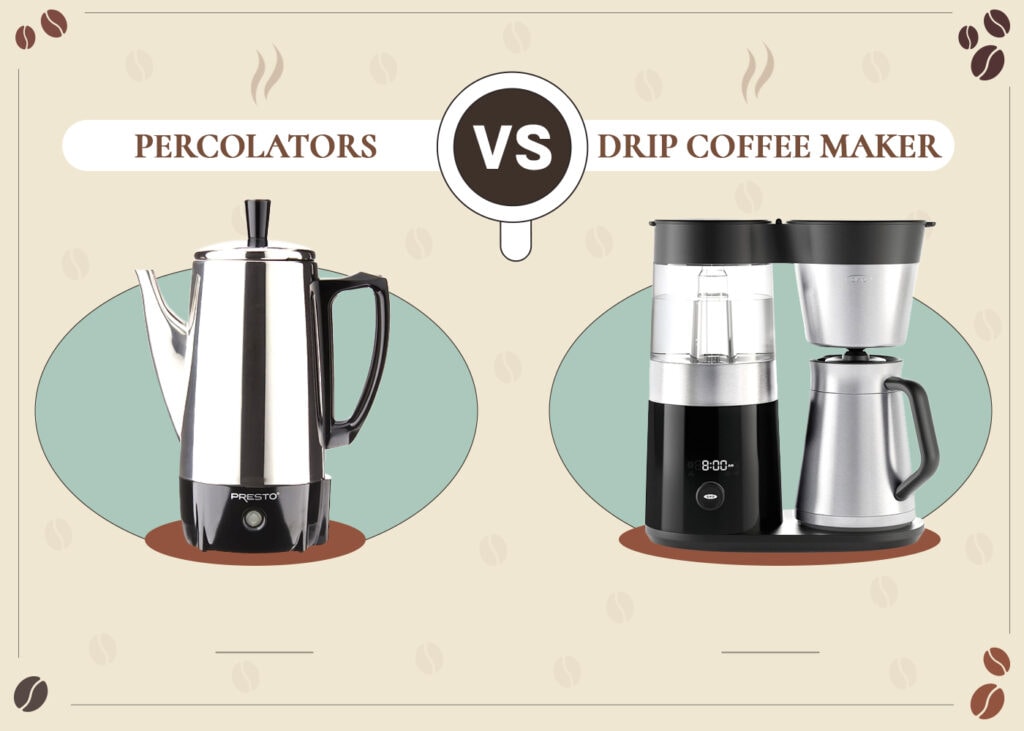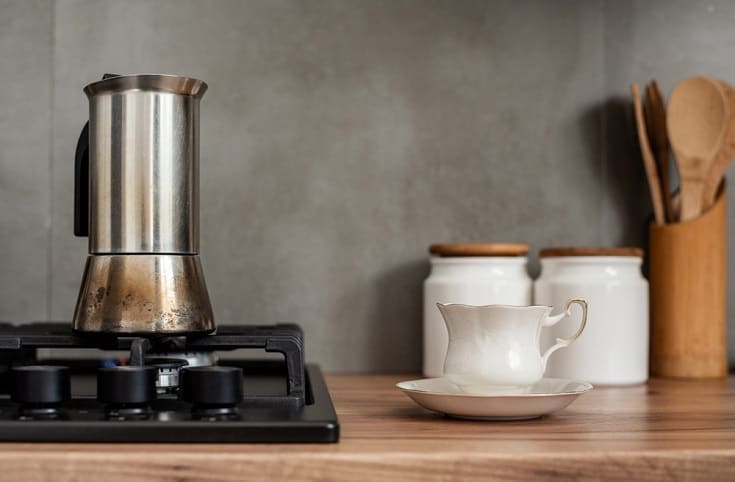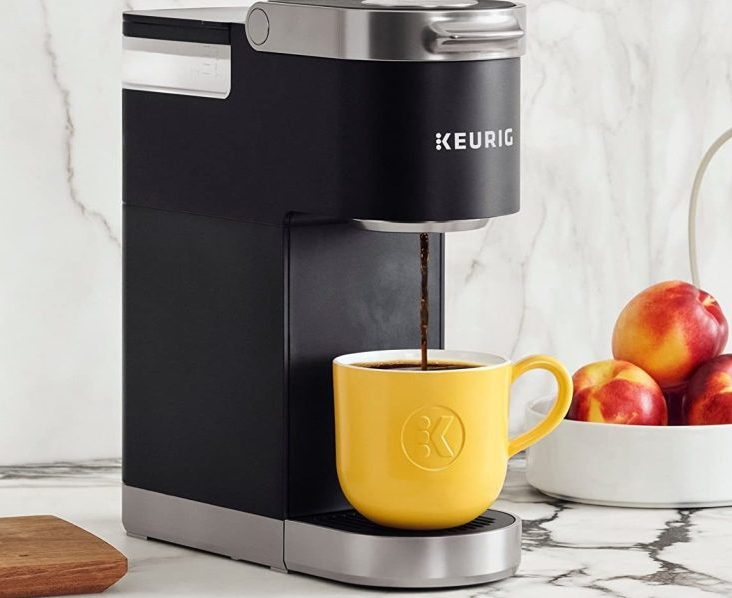
It seems like there are as many ways to brew coffee these days as there are bean varieties. But one of the oldest brewing debates involves the two most traditional brewers: percolators and drip coffee makers. Both are economical, both are convenient, and both can make those early mornings more welcoming. But is one better than the other? The short answer is, it depends entirely on your taste. Some of us prefer the subtler notes of a clean cup, while others want the teeth-kicking impact of a heavy brew. Each machine provides a vastly different coffee experience because what comes out of your coffee maker is entirely dependent on mechanics. Let’s break it down.
Bodum Bistro

How does a percolator work?
A British physicist, Count Rumford (aka Sir Benjamin Thompson), is credited with inventing the percolator in the early 1800s, and the device was first patented in America by James H. Mason in 1865. This long history means the percolator has earned its chops as a time-tested method.
One great thing about percolators is how simple they are — not to mention, easy to use. A percolator has a metal basket filter to hold your coffee grinds. When the water is heated from below—typically on a stovetop or campfire—the water travels upward through a thin tube, creates condensation in the percolator’s top, and then drips down into the basket and saturates the coffee. Once the water has absorbed the soluble parts of the bean, it drips into the pot and is recycled back up the tube. This means your coffee will be brewed and re-brewed until you are ready to pull it from the heat.
Percolators come in countless sizes and shapes, but their portability often comes in handy for camping or for storing them in small spaces. Larger percolators can also brew much larger batches for parties or commercial use, a feature that is typically lacking in drip machines.

How does a drip coffee maker work?
Melitta Bentz invented the drip coffee maker in 1908, a hundred years after the percolator appeared. Her method of discovery was simple. She punched holes in a tin cup and lined it with blotter paper, a humble beginning to one of the most popular brewing methods in history.
Of course, modern drip coffee makers are far more complex than Bentz’s makeshift creation. A drip coffee maker uses separate compartments to heat, brew, and store the coffee. This means the water passes through the machine and saturates the beans only once.
To use a drip machine, you add room-temperature water to the reservoir and scoop coffee grounds into the filter basket, which can be lined with either a metal or a paper filter. Anything from a fine to a coarse grind will work well with paper filters, and either way, none of the coffee’s oils or particles will wind up in your cup. If you’re using a metal filter, a coarse grind will work better for the same reason it works better with a percolator. You don’t want grit in the bottom of your cup.
Single-cup pod brewers have also gained significant usage within the last decade. While these machines offer less flexibility in bean size, brew time, or taste, the convenience and speed of brewing attract many buyers. But the downside with most drip brewers is their lack of portability and the real estate they require on your countertop.

What kind of coffee do you like?
Here’s where personal preference steps in. If dark, strong coffee suits you, the percolator is your friend. Its recycling and re-brewing mechanics mean your coffee will get stronger the longer it brews. But the taste of percolated coffee is often bitter. The machine robs the subtler tones of the beans as the flavors become over-extracted. But more brewing also means more caffeine extraction. If you’re seeking a quick energy jolt, this is probably where you’ll want to spend your money. Despite its tendency for dark brews, however, a percolator still has some flexibility. Lowering your brew time or adjusting your grind can augment your coffee’s quality.
If you’re looking for a light- to medium-bodied brew, the drip coffee maker will pave your way. Passing your coffee through a paper filter prevents oils and fines from reaching your cup. While this will make for a less silky mouthfeel (the physical sensation of coffee in the mouth), it will produce a clean, flavorful cup. Most of the flavor subtleties lost from percolation will make it into your brew, as well. You can adjust your grind (finer for darker coffee, coarser for lighter), as well, to find your ideal balance between flavor and boldness. Pod brewers tend to offer a more singular taste experience, although the myriad roast types and flavors available can add some interesting variety to your cup.

The Cost Conundrum
At first glance, percolators may seem like the more economical choice between the two brewers, but the options for both are widespread. In the percolator camp, a simple, stovetop or camping version can cost somewhere in the ballpark of $8 to $20. A higher-tech, electric version can run the gamut from $20 to $200. Percolators also come in a wide range of sizes, from brewers that make a few cups to larger urns that can turn out over 40 cups.
Drip coffee makers may have a greater cost spread, but their technological capabilities are equally varied. A simple, standard-size brewer could cost as little as $10, but a high-quality programmable brewer could range between $20 to $50. In the mid-range, pod brewers can cost from $30 to $500, depending on the technical specs. On the higher end, bean-to-cup brewers (which feature a built-in grinder) can set you back up to $5000. Features like touchscreens, smart home technology, or milk steamers can add significant cost to these machines, as well.

Percolator vs Drip Coffee Maker: Key Differences
Should you buy a percolator?
- Time-tested and easy to use
- Don’t need paper filters
- Very portable and compact
- Inexpensive
- Great for camping
- Very strong coffee
- Coffee may be burnt or bitter
- Requires more setup and monitoring
- No features like programming or warming plates
Should you buy a drip coffee maker?
- Fresh coffee at the push of a button
- Extra features like programming and auto-off
- Can brew large pots
- Coffee stays hot for several hours
- Can produce more subtle flavors
- Require frequent cleaning
- Need to buy paper filters
- Large price range
- Less portable and take up lots of counter space
While the pros and cons of each brewer style are multifaceted and largely dependent on personal taste, drip coffee makers have become quite popular worldwide. With an expected market upwards of $170 million this year, the drip coffee maker industry is strong. But even though drip coffee makers have made great advances recently, percolators have been selling strongly for over 200 years. Either way, both models are probably here to stay. Which one you prefer depends on your palate, your pocketbook, and your personal preference. Enjoy your coffee!
SEE ALSO:















